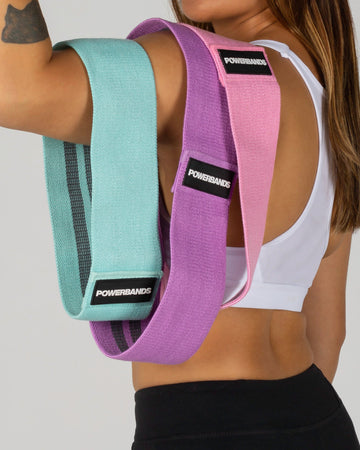A classic pull-up uses your core and upper body strength, engages your upper back muscles, and targets your latissimus dorsi (commonly referred to as “lats”), shoulder, and lower trapezius muscles. Pull-ups are gruelling exercises, but they can improve your core, upper body, and grip strength. It can also strengthen your back and prevent injuries for athletes like volleyball and baseball players.
Pull-ups are hard to do, but they are not impossible. You just need a little help from these wonderful things called assisted pull-up bands.
Assisted Pull-Ups
Like classic pull-ups, assisted pull-ups require upper body and core strength and engage the same muscle groups. It also has the same benefits of strengthening your back, upper body, core, and grip.
The primary difference between a classic and an assisted pull-up is the use of resistance bands to help you along the way. This little bit of aid makes assisted pull-ups ideal for people who want to learn the proper form of a classic pull-up and like to work their way up to doing unassisted ones.
If you think assisted pull-up band exercises are for you, then keep reading to learn more about assisted pull-up variations.
Level 0: Dead Hangs
Before attempting a pull-up, you have to work on your dead hangs first. Dead hangs will help your body develop the grip strength needed to do pull-ups.
Instructions:
- Use a bench or stool to reach a secured overhead bar.
- Grasp the bar with your hands facing away from you.
- Move your feet away from the bench or stool.
- Remain hanging from the bar with your arms straight for as long as you can.
Goal: A ten-second goal is a great place to start, but it’s better to hang for a longer period.
Level 1: Partial Pull-Ups
As the name implies, partial pull-ups are pull-ups where your chin doesn’t need to reach the overhead bar.
Instructions:
- Loop a resistance band on a secure overhead bar.
- Using an overhand grip, position your hands slightly wider than your shoulders.
- Place your feet or knees on the exercise band and lift your body as high as you can.
- Try holding your body for thirty seconds before going down.
Goal: Lifting your body an inch or so off the ground is a good start. Work on increasing your maximum height until your chin reaches the bar.
Level 2: Negative Assisted Pull-Up
Now that you’ve mastered the partial pull-up, you need to learn how to smoothly descend from the bar without injuring yourself—enter the negative assisted pull-up.
Instructions:
- Loop an assisted pull-up band on an overhead bar.
- Stand on a chair or block and position your hands similar to when you’re doing a partial pull-up.
- Carry your body until your chin reaches the bar while moving your feet off the chair or block.
- Position your knees or feet on the resistance band.
- Lower your body slowly until you reach the pull-up’s starting point.
Goal: See if you can try lifting your body until your chin reaches the overhead bar. Otherwise, try lifting your body as much as you can, then use the block again.
Level 3: Assisted Pull-Ups
Once you master the negative assisted pull-up, the next challenge is the assisted pull-up.
Instructions:
- Secure the exercise band on the overhead bar.
- Using an overhand grip, position your hands a few inches wider than your shoulders.
- Place your feet or knees on the resistance band.
- Lift your body until your chin reaches the bar.
- Maintain your position for a few seconds before slowly descending.
Goal: Work your way up to two to five sets with three to eight reps.
Conclusion
Adding pull-ups with assisted pull-up bands is a great way for pull-up beginners to receive the same benefits as classic pull-ups. You just have to find the right resistance bands and work your way up from dead hangs to assisted pull-ups.
Are you looking for high-quality assisted pull-up bands that can meet your exercise needs? Look no further than POWERBANDS®! We offer a wide range of top-quality resistance bands sought after by fitness professionals and health clubs. Visit our shop today!








